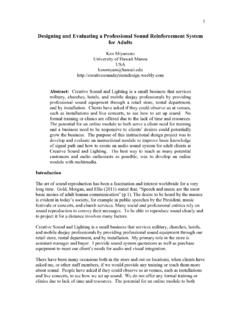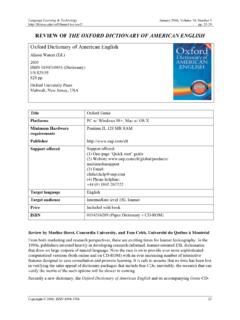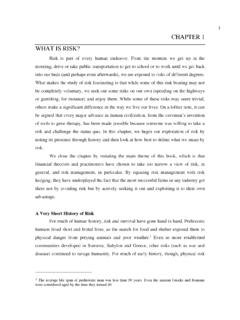Transcription of Purposive Sampling as a Tool for Informant Selection
1 Ethnobotany Research & Applications 5:147-158 (2007)Ma. Dolores C. Tongco, Department of Botany, University of Hawai`i at Manoa, 3190 Maile Way, Honolulu, HI, 96822 and Institute of Biology, University of the Philippines, Diliman, Quezon City, 1101, MethodsAbstract Informant Selection is highly relevant for ethnobotanical research, as people are constantly looked upon for knowl-edge and information. The Purposive Sampling technique is a type of non-probability Sampling that is most effective when one needs to study a certain cultural domain with knowledgeable experts within. Purposive Sampling may also be used with both qualitative and quantitative re-search techniques. The inherent bias of the method con-tributes to its efficiency, and the method stays robust even when tested against random probability Sampling .
2 Choos-ing the Purposive sample is fundamental to the quality of data gathered; thus, reliability and competence of the in-formant must be ensured. IntroductionData gathering is crucial in research, as the data is meant to contribute to a better understanding of a theoreti-cal framework (Bernard 2002). It then becomes impera-tive that selecting the manner of obtaining data and from whom the data will be acquired be done with sound judg-ment, especially since no amount of analysis can make up for improperly collected data (Bernard et al. 1986). Purposive Sampling is an Informant Selection tool wide-ly used in ethnobotany (Table 1). However, the use of the method is not adequately explained in most studies.
3 The Purposive Sampling technique, also called judgment Sampling , is the deliberate choice of an Informant due to the qualities the Informant possesses. It is a nonrandom technique that does not need underlying theories or a set number of informants. Simply put, the researcher decides what needs to be known and sets out to find people who can and are willing to provide the information by virtue of knowledge or experience (Bernard 2002, Lewis & Shep-pard 2006). Purposive Sampling is especially exemplified through the key Informant technique (Bernard 2002, Gar-cia 2006, Gustad et al. 2004, Jarvis et al. 2004, Lyon & Hardesty 2005), wherein one or a few individuals are so-licited to act as guides to a culture. Key informants are observant, reflective members of the community of in-terest who know much about the culture and are both able and willing to share their knowledge (Bernard 2002, Campbell 1955, Seidler 1974, Tremblay 1957).
4 This paper focuses on how to go about selecting people willing to impart their knowledge and experiences with plants through the Purposive Sampling method of infor-mant Selection . Examples of studies that have used pur-posive Sampling are given, including the type of popula-tion sampled, data gathering techniques, analyses done and key results. Concerns regarding the validity of this nonrandom technique and the reliability of an Informant are also tackled in this paper. Using the Purposive Sampling MethodIn choosing a Sampling method for Informant Selection , the question the researcher is interested in answering is of utmost importance. The question will decide the objec-tives on which the methodology will be based.
5 The first Purposive Sampling as a Tool for Informant SelectionMa. Dolores C. TongcoEthnobotany Research & Applications148 1. Purposive Sampling Used in Ethnobotanical Atudies. Three categories: Studies of specific skills, knowledge, or practices; Comparisons between practices; and Case of specific skills, knowledge, or practicesResearch ProblemMethodsPopulation SampledSampleAnalysesCitationCultural significance of plantsUnstructured interviewsInformants chosen based on traditional ecological knowledge, residency, professional activity, age54 peopleIndex of cultural significanceSilva & Andrade 2006 Collect information on almost-forgotten plant usesInterviewsElders with empirical knowledge132 people in 60 outlying villagesnone specifiedTardio et al.
6 2005 Use and availability of craft vinesSemi-structured interviews, direct observationsPersons involved in basket-weaving activities66 peoplePercentagesMartinez-Romero et al. 2004 Sustainability and use of gara dyeingField interviewsGara dyersnone specifiednone specifiedMcFoy 2004 Use of hemiepiphytes in craftmakingInterviews, participant observationMale craftmaking and hemiepiphyte collector specialistsnone specifiednone specifiedVargas & van Andel 2005 Construction of a clapperstickUnstructured interviews, participant observationFemale clapperstick-makers2 peoplenone specifiedWalker et al. 2004 How edible wild plants are usedFocus group discussionPeasant association based on relatively heterogeneous agroecology 6-8 peoplenone specifiedAddis et al.
7 2005 Knowledge and valuation of wild food plantsKey Informant , semi-structured interviews, informal interviewsInformants chosen based on knowledge of wild food plantsnone specifiednone specifiedGarcia 2006 Names and uses of edible wild mushroomsKey informants, interviews,Mushroom collectorsnone specifiednone specifiedJarvis et al. 2004 Medicinal properties of food in Buddhist templesInterviews, questionnairesCooks in Buddhist templesat least 2 in each of 27 templesPercentagesKim et al. 2006 Documentation of traditional healing practicesInterviewsTraditional healers none specifiednone specifiedHammiche & Maiza 2006 Contemporary traditional healingKey informants, interviews,Healers with good reputations8 peopleQualitativeLyon & Hardesty 2005 Herbs used in medicinal bathsInterviewsHerbalists, elderly villagers, local healersnone specifiedPercentagesLi et al.
8 2006 Uses of Atuna racemosa that utilized and harvested oil from Atuna racemosa6 peopleUse frequencyPrance 2004 Tongco - Purposive Sampling as a Tool for Informant of specific skills, knowledge, or practicesResearch ProblemMethodsPopulation SampledSampleAnalysesCitationEthno-pharm acological survey Interviews, questionnairesHealers of schistosomiasis40 peopleUnivariate analysis, Pearson chi-square, cross-tabulation, percentagesBah et al. 2006 Information on medicinal plantsInterviewsLocals knowledgeable in medicinal plant usagenone specifiednone specifiedBrussell 2004 Determine antifungal properties of plants traditionally used in fungal infectionsInterviews, questionnairesTraditional healers of fungal infections14 peoplenone specifiedHamza et al.
9 2006 Use of medicinal plantsInterviewsPatients based on medical historynone specifiednone specifiedRamihanta-niariyo et al. 2003 Use of medicinal plants in Candida infectionsInterviewsTraditional healers for Candida infectionsnone specifiednone specifiedRunyoro et al. 2006 Use of medicinal plants for dermatologyInterviewsHealers or families with tradition of healing, knowledge about skin ailments and cosmeticsNone specifiedFrequencies Saikia et al. 2006 Role of Cannabis in cigarette smokingInterviewsInformants chosen based on Cannabis and cigarette history59 peoplenone specifiedHighet 2004 Comparison of ethnoveterinary medicines for racehorsesInterviewsLivestock farmers60 peoplenone specifiedLans et al. 2006 Preferences of farmers in selecting shade trees Informal interviews, questionnairesSmall-scale farmers with experience regarding shade trees83 peopleFrequencies, chi-squareAlbertin & Nair 2004 Potential for sustainable harvestingInterviews, direct observations, freelistingCarpenters, harvesters, foresters, households, store owners, merchantsat least 18 peoplePercentagesAnderson 2004 Cacao farmers understanding regarding shade trees Semi-structured interviews, surveyCacao farmers21 peoplenone specifiedBentley et al.
10 2004 Use and value of tree productsKey informants, interviews,Buyers or sellers of market tree products43 peoplenone specifiedGustad et al. 2004 Use of landscape visualization in forest management involving indigenous groupsInterviewsInformants chosen based on criteria of knowledge, role in community and communication skills11 peoplenone specifiedLewis & Sheppard 2006 Ethnobotany Research & Applications150 of specific skills, knowledge, or practicesResearch ProblemMethodsPopulation SampledSampleAnalysesCitationEvaluation of trees for reforestation and agroforestryInterviews, listing, categorizingInformants chosen based on gender, farm, location, farm activity27 peoplenone specifiedMcDonald et al. 2003 Use of poisonous plants as insecticidesInterviews, participant-observationSpecialists representative for each area and ecological regionnone specifiednone specifiedOrozco & Lentz 2005 Comparisons between practicesResearch ProblemMethodsPopulation SampledSampleAnalysesCitationComparison of four land-use optionsInterviews, survey, focus group discussionFarmers10 for each livelihood strategy for each of 3 villagesAnalysis of variance, benefit-cost ratio, returns to labor, sensitivity analysis, net present valueBelcher et al.
















